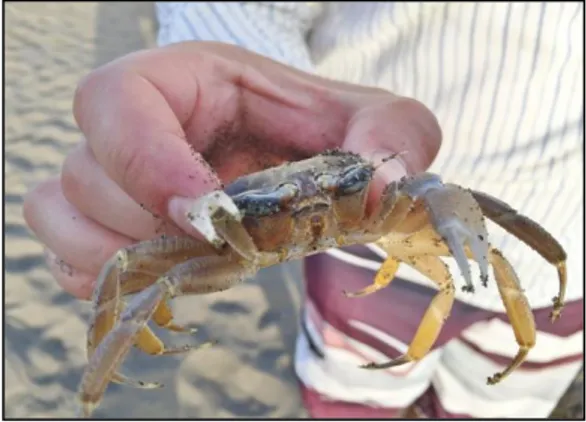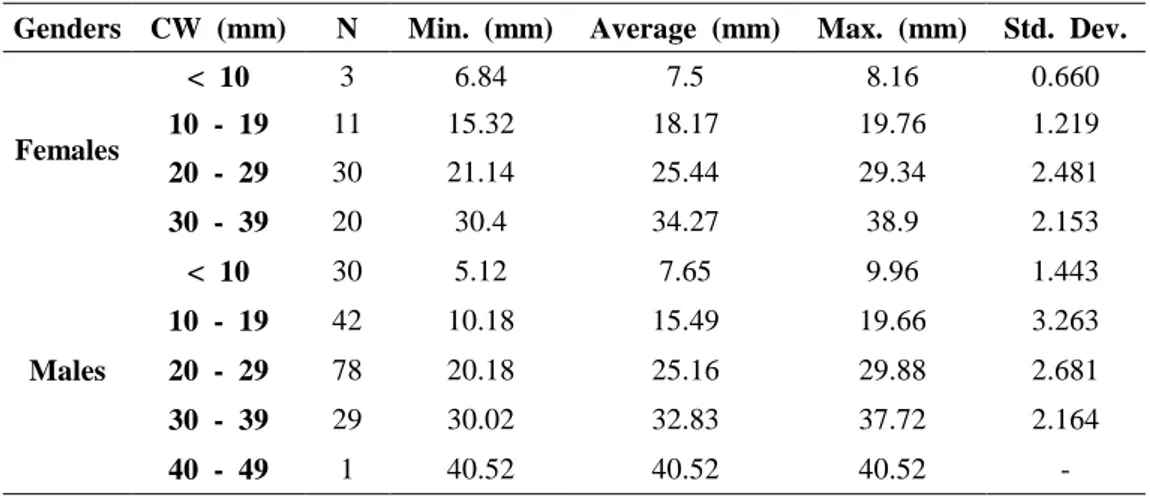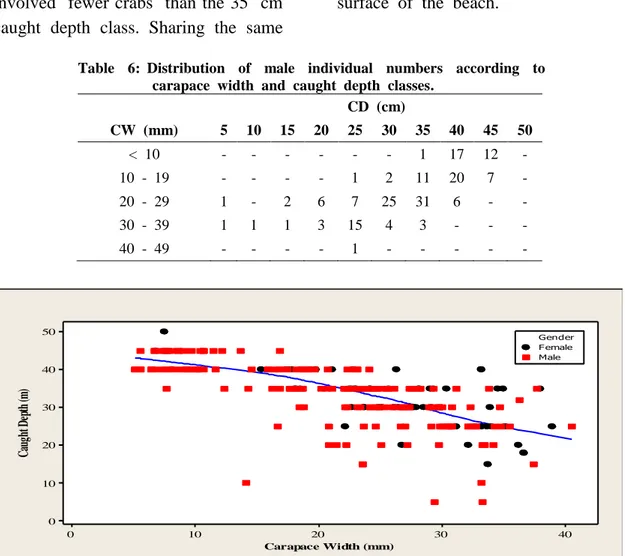Studying on relationship between carapace width and habitat
properties of Tufted ghost crab (Ocypode cursor) living on
Iztuzu beach–Turkey
Yılmaz Ö.
1*; Barlas M.
2Received: November 2016 Accepted: February 2016
1- Veterinary Department, Alaca Avni Çelik Vocational School, Hitit University, Turkey
2- Biology Department, Faculty of Science, Muğla Sıtkı Koçman University, Turkey *Corresponding author's Email: ozgenyilmaz@hitit.edu.tr
Keywords: Iztuzu Beach, Ocypode cursor, Carapace width, Caught depth, Behavior model.
Introduction
The genus Ocypode is represented by 21 species worldwide and the distribution regions of these species are the coasts of the Atlantic Ocean, the Mediterranean Sea, Eastern Pacific Ocean and the Indo-Western Pacific Ocean (Sakai and Türkay, 2013). These crabs which have extensive dispersal along sandy-beach ecosystems are of high importance because of their roles as both predators and beach scavengers to maintain the health of their habitats (Wolcott, 1978; Brown and McLachlan, 2006). When existence of ocypodid crabs living on beaches was examined carefully and comprehensively, it was determined that they possess the ability of being important indicator organisms for the assessment of anthropogenic impacts on sandy beaches (Barros, 2001). Ocypodid crabs have terrestrial dispersal and they dig
semi-permanent burrows which they protect along the coast (Brown and McLachlan, 2006). It was stated that burrows of ghost crabs can modify the complexity of sandy beaches and play an important role in productivity and in affecting their physical environment. Ghost crab burrows may vary in architecture by tidal changes and beach slope. For example, it was reported that in India, J-, U- and Y- shaped burrows were found (Chan et al., 2006). The number of studies about the burrow morphology of ghost crabs are scant (Seike and Nara, 2008).
From the results of observations made in the field during the catch of ghost crabs found in burrows with various morphologies, a behavior model of Ocypode cursor was realized and this model constituted the hypothesis of current study. According to the hypothesis proposed here, there is a negative
correlation between the carapace width and caught depth of O.
cursor. Considering this concept, the
aim of this study was to scientifically and statistically test the aspects which researchers should be aware of during the catch of ghost crabs – while less is known about their behavior patterns.
Materials and methods
Data, related to 244 ghost crabs’ (O.
cursor) carapace width, distances of
burrows from the sea and caught depth were collected from May 2014 to May 2015 from İztuzu Beach which is 5 km long in southwestern Turkey. Crab burrows were dug using plastic shovels. Measurements of crabs and distances were made using a caliper with 0.02 mm sensitivity and a roller meter (50 m), respectively. During the field study, both random sampling and catch-measure-release methods were applied.
Because O. cursor (Fig. 1) individuals have sexual dimorphism, data related to carapace width, distances of burrows from the sea and caught depth were processed separately for each gender. Recorded data were processed by MS Office
Excel’07 and Statistica’7 to reveal the statistical background. From the statistical results, standard deviation values and correlation matrices were used to test the hypothesis of study.
Figure 1: Ocypode cursor.
Carapace width
Carapace width, which is the measure of the broadest part along the line lying dorso-laterally on the crabs’ carapace was used as the basic parameter in determining the body size of crabs. According to carapace width, distribution of individual numbers on the basis of gender was shown in Table 1. Also, minimum, average, maximum and standard deviation values were listed. It was seen that the number of individuals was highest in the 20 and 29 mm carapace width class of the sample pool (females: 30 ind., males: 78 ind.).
Table 1: Distribution of individual numbers according to carapace width classes on the basis of genders (CW: carapace width, N: number of individuals, Std. Dev.: standard deviation).
Results
Distances of burrows from the sea
Distances of burrows from the sea is a parameter pointing to the distance from the center of the crab burrows to the sea. Distribution of individual numbers on the basis of genders is shown in Table 2. It was determined
that both genders of Ocypode cursor prefer to use the first 10 m band landwards on İztuzu Beach. A decrease in digging burrow activity was recorded as ghost crab individuals get farther from the sea.
Table 2: Distribution of individual numbers according to the distances of burrows from the sea on the basis of genders (DBS: distances of burrows from the sea).
Caught depth
Caught depth is the measure of the distance from the burrow aperture on the beach surface to the depth that ghost crabs were caught. Table 3
presents the number of individuals recorded at different caught depth classes on the basis of genders. While the highest numbers of ghost crab individuals were determined
Genders CW (mm) N Min. (mm) Average (mm) Max. (mm) Std. Dev.
Females < 10 3 6.84 7.5 8.16 0.660 10 - 19 11 15.32 18.17 19.76 1.219 20 - 29 30 21.14 25.44 29.34 2.481 30 - 39 20 30.4 34.27 38.9 2.153 Males < 10 30 5.12 7.65 9.96 1.443 10 - 19 42 10.18 15.49 19.66 3.263 20 - 29 78 20.18 25.16 29.88 2.681 30 - 39 29 30.02 32.83 37.72 2.164 40 - 49 1 40.52 40.52 40.52 - Genders DBS (m) N Females 1-4.9 37 5-9.9 26 10-14.9 - 15-19.9 1 Males 1-4.9 100 5-9.9 76 10-14.9 3 15-19.9 1
from 35 cm depth (18 females and 46 males); the lowest numbers for females (1 ind. for each depth classes) were caught from 45 and 50 cm depths andthe lowest numbers for males (2 inds. for each depth
classes) were obtained from 5 and 10 cm depths. No females were sampled from 5 and 10 cm depth classes and no males were sampled from 50 cm depth class.
Table 3: Number of individuals recorded at different caught depth classes on the basis of genders (CD: caught depth).
Data associations
Correlation matrices were used for the association of data. Carapace width, distances of burrows from the sea and caught depth parameters were used to test the proposed hypothesis.
With respect to Table 4, while no statistically significant (p<0.05)
correlation was found between carapace width and distances of burrows from the sea and, between distances of burrows from the sea and caught depth; a negative correlation was found (r=-0.69 for females and r=-0.70 for males;
p<0.05) between carapace width and
caught depth.
Table 4: Pearson’s correlation matrix for carapace width, distances of burrows from the sea and caught depth on the basis of genders (p<0.05).
Ocypode cursor is a ghost crab
species with sexual dimorphism. Thus, instead of considering data in a pooled form, separated analysis for each gender was suggested to infer the role of gender in the hypothesis. To this end the distribution of individual numbers in caught depth classes, according to the carapace width classes of females and males is presented in Tables 5 and 6.
In Table 5 and Fig. 2, which represents females, it was seen that the 40 cm caught depth class is the richest in that it includes individuals of ifferent carapace widths. However this depth class involves fewer crabs when compared with the 35 cm depth class. Also, it was determined that crabs smaller than 10 mm were caught deeper than those larger than 30 mm. Crab individuals larger than
Females Males
CD (cm) 5 10 15 20 25 30 35 40 45 50 5 10 15 20 25 30 35 40 45 50 N - - 3 3 9 14 18 15 1 1 2 2 3 9 24 32 46 43 19 -
Genders Females (N=64) Males (N=180)
Parameters CW CD DBS CW CD DBS
CW 1.00 -0.69 -0.01 1.00 -0.70 0.10
CD 1.00 -0.23 1.00 -0.13
30 mm in carapace width were observed relatively closer to the
beach surface.
Table 5: Distribution of female individual numbers according to carapace width and caught depth classes.
In Table 6 and (Fig. 2), representing males, it was shown that the 25 and 35 cm depth classes are richest in individuals of different carapace width classes. These depth classes involved fewer crabs than the 35 cm caught depth class. Sharing the same
pattern with females, males smaller than 10 mm were caught from a deeper portion of their burrows whereas crabs larger than 30 mm were found to be closer to the surface of the beach.
Table 6: Distribution of male individual numbers according to carapace width and caught depth classes.
CD (cm) CW (mm) 5 10 15 20 25 30 35 40 45 50 < 10 - - - 1 17 12 - 10 - 19 - - - - 1 2 11 20 7 - 20 - 29 1 - 2 6 7 25 31 6 - - 30 - 39 1 1 1 3 15 4 3 - - - 40 - 49 - - - - 1 - - - - -
Figure 2: Schematic representation of relations between individual numbers, carapace width and caught depth of both genders.
CD (cm) CW (mm) 5 10 15 20 25 30 35 40 45 50 < 10 - - - 1 1 1 10 - 19 - - - 3 8 - - 20 - 29 - - - 1 1 13 11 4 - - 30 - 39 - - 3 2 8 1 4 2 - - 40 - 49 - - - - 40 30 20 10 0 50 40 30 20 10 0 Carapace Width (mm) C au gh t D ep th (m ) Female Male Gender
Discussion
In respect to the suggested hypothesis in the current behavior study which depends on data related to 244
Ocypode cursor individuals sampled
from İztuzu Beach, ghost crabs with larger carapace width (>20 mm), whose burrows were dug, were found to be closer to the beach surface to escape compared to the smaller crabs (<20 mm). According to Table 7, a negative correlation is seen which is statistically significant (r=-0.69 for females and r=-0.70 for males; p<0.05). The time burrows tracked down into the sandshow that
the descending arm ascends before the bottom portion of burrow reaches the water table. Because it is difficult to track smaller crabs down in the ascending arm of the burrow, it can be proposed that smaller crabs prefer to dig deeper and further underneath the sand. And it can be said that larger crabs have larger muscle mass and so can move faster and therefore do not prefer to hide but escape while they are still close to the sand surface. Also it should be noted that gender plays a role in this behavior model.
Table 7: Extracted correlation matrix for carapace width and caught depth on the basis of genders (p<0.05).
Few studies were encountered in the literature on the behavior of ghost crabs. These studies generally are focused upon the activity patterns of the organisms (Strachan et al., 1999; Türeli et al., 2009; Haque and Choudhury, 2014). On the other hand, it was stated that ghost crabs show an escaping reaction against the movement of shadow or light beam (Wolcott, 1978). No study associating caught depth and ghost crab behavior have been found. For
O. cursor and other ghost crabs, this
study is the first in which “caught depth” data was collected and its possible role in ghost crab behavior was discussed.
Similar studies should be carried out in different localities and on different species to understand the other reasons and variations of this behavior model. In addition to expanding the scientific point of view, it is important to recognize other behavior models to prevent organisms from being harmed during the sampling phase of studies. Field observations are very important for monitoring, recording and testing these behaviors. It is thought that such information also would increase the efficiency of scientific studies. References
Barros, F., 2001. Ghost crabs as a tool for rapid assessment of
Genders Females (N=64, p<0,05) Males (N=180, p<0,05)
Parameters CW CW
human impacts on exposed sandy beaches. Biological Conservation, 97, 399-404.
Brown, A.C. and McLachlan, A., 2006. The ecology of sandy shores. Elsevier Inc., London. 392 P.
Chan, B.K.K., Chan K.K.Y. and Leung, P.C.M., 2006. Burrow architecture of the ghost crab
Ocypode ceratophthalma on a
sandy shore in Hong Kong.
Hydrobiologia, 560, 43-49.
Haque, H. and Choudhury, A., 2014. Ecology and behavior of the ghost crab, Ocypode macrocera Edwards, 1834 occurring in the sandy
beaches of Sagar Island,
Sundarbans. International Journal of
Engineering Science Invention, 3(4),
38-43.
Sakai, K. and Türkay, M., 2013. Revision of the genus Ocypode with the description of a new genus, Hoplocypode (Crustacea: Decapoda: Brachyura). Nature, 56(2), 665–793.
Seike, K. and Nara, M., 2008. Burrow morphologies of the ghost crabs
Ocypode ceratophthalma and O. Sinensis in foreshore, backshore,
and dune sub environments of a sandy beach in Japan. Journal of
the Geological Society of Japan,
114(11), 591-596.
Strachan, P.H., Smith, R.C., Hamilton, D.A.B., Taylor A.C. and Atkinson, R.J.A., 1999. Studies on the ecology and behavior of the ghost crab, Ocypode cursor (L.) in northern Cyprus. Scientia Marina 63(1), 51-60.
Türeli, C., Duysak, Ö., Akamca, E. and Kıyagı, V., 2009. Spatial distribution and activity pattern of the ghost crab Ocypode cursor (L., 1758) in Yumurtalık Bay, north-eastern Mediterranean-Turkey. Journal of Animal and
Veterinary Advances, 8(1), 165-171.
Wolcott, T.G., 1978. Ecological role of ghost crabs, Ocypode quadrata (Fabricius) on an ocean beach: scavengers or predators? Journal of
Experimental Marine Biology and Ecology, 31, 67-82.




